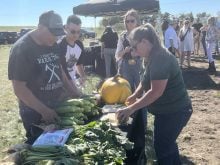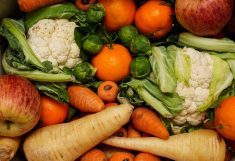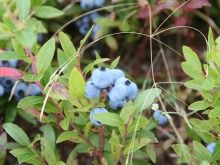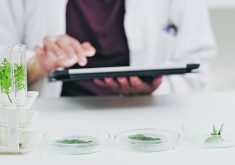Researchers say it’s important to understand this fertilization process because many food crops are derived from flowers
Research by scientists at the University of Maryland has furthered the understanding of the mechanism that prompts the precise time when flowering plants produce fruit.
The research identified the gene responsible for triggering plants to develop seeds and provided knowledge that could lead to increasing grain and fruit size, as well as potentially creating fruits that bypass pollination.
“Understanding this process (of fertilization) is especially important because common food crops such as peanuts, corn, rice and strawberries are all derived from flowers,” said Zhongchi Liu, professor in the department of cell biology and molecular genetics. “Knowing how plants decide to turn part of their flowers into fruit and seed is crucial to agriculture and our food supply.”
Read Also

New coal mine proposal met with old concerns
A smaller version of the previously rejected Grassy Mountain coal mine project in Crowsnest Pass is back on the table, and the Livingstone Landowners Group continues to voice concerns about the environmental risks.
While strawberries are a popular seasonal fruit, according to Statistics Canada, the field production area across Canada has shrunk by one-third in the past 20 years, falling from 15,315 acres in 2000 to 10,125 acres in 2021. More than half of all strawberries grown in Canada in 2021 came from Quebec (13,419 tonnes).
Recently, strawberry farmers have faced increasing challenges with pathogens, insect pests, drought and untimely rain.
With increasingly hot summers, Liu said that greenhouse strawberries do not set fruit well because the pollen reacts to heat. In a warming climate, fruit pollen will continue to be very sensitive, which can adversely affect food production.
Studies have also shown that warmer springs are causing bees to hatch earlier, putting them out of sync with the flowers that they pollinate. Insects are responsible for pollinating around 85 percent of commercial crops and many plants have evolved to specifically attract certain insects.
The search for the gene that regulates seed development began, for Liu, a decade ago. Liu’s team focused on strawberries, which as an “inside-out” fruit, is a valued plant to study for food development because the seeds are on the outside of the fruit, making them highly accessible and easier to manipulate and observe. The brownish or white specks are the true fruit, called achenes, and each of them surrounds a tiny seed.
“As an inside-out fruit, it is easier for us to view the seeds and extract genetic information from them at multiple stages of plant development,” she said. “We know that pollination can trigger auxin synthesis in the seeds. It is this pollination-triggered auxin production that is necessary to initiate fruit formation. Our research is focused on understanding how pollination induces auxin synthesis and what genes are involved.”
Liu and her team suspected that there was an internal communication system, a messenger, for signalling the plant to initiate the development of fruit. To find out, they simulated pollination and fruit development mechanisms to observe how fertilization induces the plant growth hormone auxin to promote the onset of fleshy fruit. Auxin is a key regulator of plant growth and development.
In the process, the team identified AGL62, a gene universally found in all flowering plants, as the trigger to a plant’s production of fruit and seed. AGL62 is prompted by pollination to stimulate the onset of the production of auxin. Once AGL62 activates, auxin is synthesized to create the seedcoat, the endosperm and the fruit. Auxin’s role in regulating endosperm growth is especially important because it impacts the size of the grain and fruit enlargement.
“Auxin levels can limit how big an endosperm can grow and how much nutrition endosperm can accumulate for a plant embryo,” said Liu. “When there is less auxin, endosperms are unable to feed plant embryos properly and we end up with lower crop productivity and with smaller or deformed fruits that aren’t commercially viable. Strawberry is both wind and insect pollinated so you can have evenly distributed pollination. But if you don’t have even pollination, you get dents on the fruit where the seed is not fertilized. No fruit grows around it. That affects the quality of the fruit.”
Confirming that AGL62 was the trigger to set auxin in motion, team member Lei Geo used CRISPR to manipulate the gene and disrupt its function. The strawberry strain Yellow Wonder Fragaria vesca was used. The plants were grown in a growth chamber with a 16-hour light at 25 C followed by an eight-hour darkness at 22 C with a relative humidity of 50 percent.
The CRISPR manipulation of knocking out AGL62 resulted in the test strawberry plants unable to grow seed and fruit, demonstrating how critical the role of the gene was in orchestrating fruit development. Removing it resulted in no fruit production.
“The CRISPR experiment proved that the gene is doing what we think it is doing, i.e., triggering the production of auxin,” said Liu. “We are proving that this gene is an important messenger.”
Liu and her team believe they have laid the foundation that may allow researchers to use biotechnology and bypass pollination. The process would create “virgin” fruits, also known as parthenocarpy. This ability for some plants to supersede the need for fertilization has contributed to some of the oldest domestic crops such as breadfruit (a tree of the mulberry family producing large football-size fruit) and bananas. Liu believes that the development of virgin fruit would be especially important, given how climate change is affecting food production.
“AGL62 is switched on by pollination,” said Liu. “Once it is on, AGL62 subsequently switches on auxin synthesis in the seeds. Therefore, if we could find a way to switch on AGL62 without depending on pollination, we can then induce fruit formation. This is one of our goals as we can then bypass pollination and ensure fruit formation without worries about pollinator availability or too high or too low temperatures for pollen development. Our next step is to find out how AGL62 is switched on by pollination. This will help us reach the goal of producing pollination-independent fruit.”
The research was published in the journal Nature Communications.

















